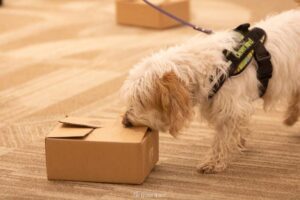
I Sniff, Therefore I Am
Discover the facts about a dog’s sense of smell and how it differs from ours. Learn about the nature of a dog’s nose and scent perception.
Home » Dog Breeds » Petit Basset Griffon Vendeen Dog Breed
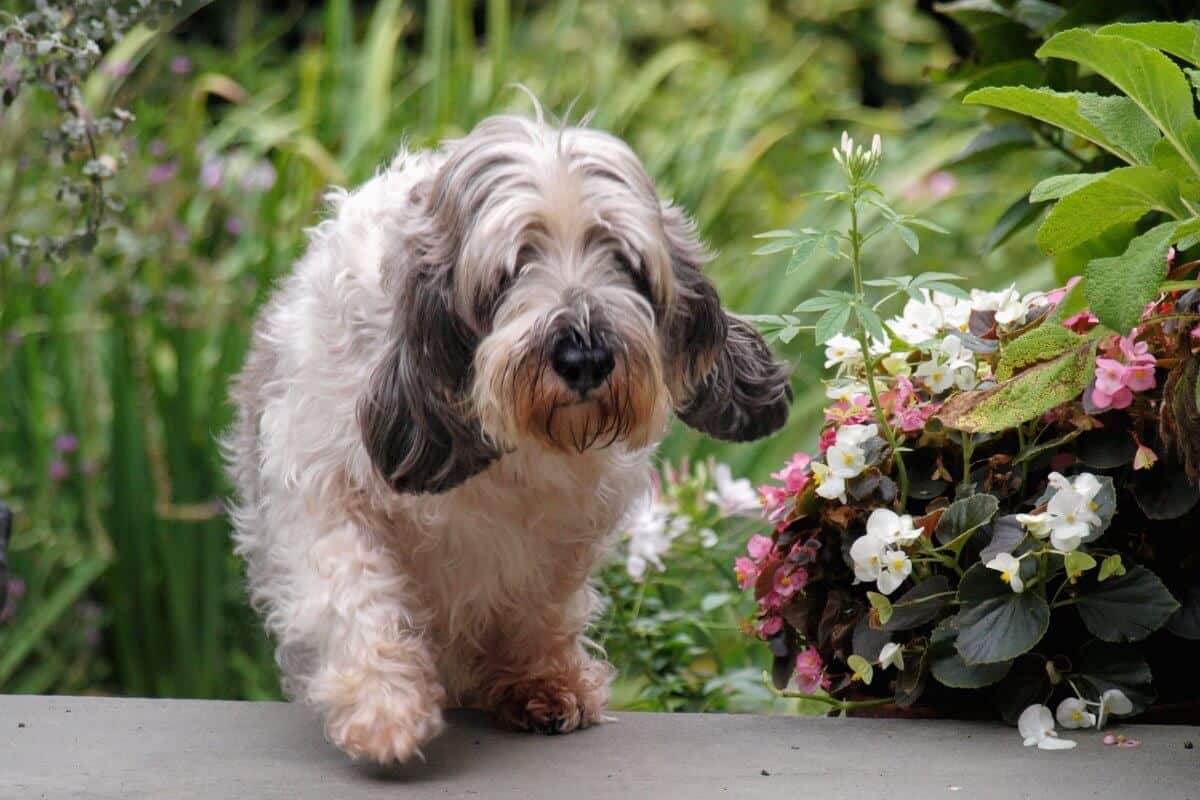
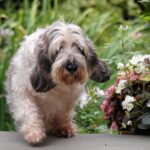
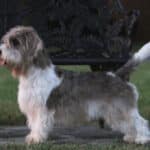
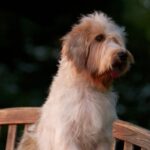

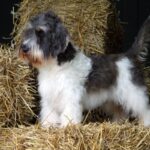
The Petit Basset Griffon Vendéen, often abbreviated as the PBGV, is a small, vivacious French hound known for its rough, tousled coat and enthusiastic spirit. Steeped in a rich hunting tradition, the breed was developed to track small game over the rough and challenging terrain of the Vendée region. Its name is descriptive of the dog’s many attributes: “Petit” means small; “Basset” indicates it is low to the ground; “Griffon” refers to the rough and wiry coat; and “Vendéen” ties it to its region of origin.
Hound
13 – 15 Inches
25 – 40 Pounds
14 – 16 Years
| Country of Origin | France |
|---|---|
| Bred For | Hunting in Packs, Companionship |
| Known For | Outgoing Personality, Stubbornness, Adaptability |
| Popularity | Low |
| Temperament | Confident, Happy, Extroverted |
| Activities | Hunting, Running, Hiking, Conformation Shows, Dog Sports |
Tracing its roots to the Vendée region of Western France, the Petit Basset Griffon Vendéen, commonly abbreviated as PBGV, is a breed with a rich hunting history. Historical records suggest that ancestors of the modern PBGV have been around since ancient times. However, specific references to the “Basset” type of French hounds began emerging in the 16th century. The primary role of these dogs was hunting small game, especially rabbits.
By the 19th century, distinctions were becoming more pronounced among the Bassets of France. The challenging terrain of the Vendée, which is marked by dense underbrush and a rugged landscape, demanded a hound with specific attributes that made it suitable for terrain. Thus, the breed’s short legs, rough coat, and keen sense of smell made it particularly adept at pursuing game throughout the region.
The PBGV was formally distinguished from its larger cousin, the Grand Basset Griffon Vendéen, based on its size, appearance, and hunting capabilities. As the breed’s popularity grew, especially in the show ring during the late 19th and early 20th centuries, breeders started to refine the breed and established a written Breed standard.
The Fédération Cynologique Internationale (FCI) officially recognized the Petit Basset Griffon Vendéen in 1976, marking a significant milestone for the breed on the international stage. This recognition was a testament to its distinctive qualities and its growing popularity outside of France. The American Kennel Club (AKC) also granted official recognition to the PBGV in 1990.
Today, the PBGV is celebrated not just for its historical significance as a proficient hunting dog but also for its vivacious personality and endearing demeanor. Its journey from the rugged landscape of France to the living rooms of enthusiasts worldwide is a testament to its adaptability, resilience, and charm.
Adult Petit Basset Griffon Vendéens typically stand around 13 to 15 inches tall at the shoulder. A height over 15 inches is unacceptable in this small hunting hound.
Weight-wise, both males and females generally range between 25 and 40 pounds, with slight variations due to a hound’s genetics and lifestyle.
The Petit Basset Griffon Vendéen is longer than it is tall, creating a somewhat rectangular profile. For the PBGV, proportions are measured from the point of shoulder to the buttocks and from the withers to the ground. This hound’s substance is solid without being heavy, and it showcases a muscular physique that’s indicative of the breed’s stamina and endurance in the field. The general impression is harmonious and well-proportioned , with no exaggerated features.
Texture: The Petit Basset Griffon Vendéen possesses a distinctive rough and tousled double coat with a casual appearance. There is a harsh outer coat and a shorter, thicker undercoat. The head sports distinctive eyebrows as well as a beard and mustache, and the ears are covered in long hair. The tail is also well furnished with hair. No scissoring or shaping is needed to keep the coat looking its best.
| Standard Color | ||
|---|---|---|
| White & Grizzle | ee | |
| White & Lemon | ee | |
| White & Orange | ee | |
| White & Sable | ee | |
| White Black & Tan | ee | |
| Black & Tan | ee | |
| Fawn | ee | |
| White & Black | ee | |
| White & Gray | ee |
Markings: The Petit Basset Griffon Vendéen’s coat can vary greatly in pattern. The white base color can have few colored markings or it may be heavily marked. Markings may appear as patches or as a blanket and patches. Patches are clearly defined and may be mixed with ticking throughout the longer white hairs.
A Note About Color: Acceptable coloration varies from dog to dog and even from country to country, though a white ground is generally required to allow the PBGV to be easily seen in the field.
The tail of the Petit Basset Griffon Vendéen is an expressive breed feature, set high and carried proudly. It is of medium length, reaching no further than the hock joint. The tail tapers to a point and is covered with long, harsh hair, echoing the body’s coat texture. When the PBGV is in action or alert, the tail is often carried in a saber-like fashion in the two o’clock position, emphasizing the breed’s lively disposition.
The decision to add a Petit Basset Griffon Vendéen to the home requires an understanding of this spirited breed’s unique characteristics and behaviors. The PBGV is an energetic and enthusiastic companion, with the independent nature of a typical scenthound. While these dogs might appear charming and easy-going, they are, at their core, hunting dogs, and they possess a high prey drive. Their spirited demeanor means they require consistent training and an outlet for their energy.
The Petit Basset Griffon Vendeéen is generally a robust dog, but like all breeds and mixed breeds, the PBGV has specific health considerations.
Lifespan: The average lifespan for a PMGV is around 14 to 16 years; a respectable age for a dog of its size.
The Petit Basset Griffon Vendéen, while a generally healthy breed, does have certain health conditions that can be of concern. Some of the potential health risks for the PBGV include:
It is crucial for Petit Basset Griffon Vendéen owners to be aware of these potential health issues and to seek regular veterinary care. Regular check-ups can help to catch and address health problems early on.
The Petit Basset Griffon Vendéen, affectionately known as PBGV, is a lively and spirited breed of dog, filled with plenty of enthusiasm and charm. These hounds typically possess a friendly and outgoing nature, making them delightful companions for families, singles, and seniors alike. As descendants of packs hunters, their keen nose and innate curiosity can often lead them on scent-driven adventures.
New dog owners may find the PBGV to be a great fit, but it is important to understand the breed’s inherent hound characteristics. These dogs can sometimes be stubborn and determined, especially when they catch an interesting scent. With gentle, consistent training methods, they can usually be taught to be obedient and well-mannered.
The breed’s social nature means these hounds will generally get along well with other dogs. While they are typically good with children, it is essential for all interactions to be supervised. The PBGV’s friendly demeanor extends to strangers too, as these dogs often greet people with wagging tails and expressions of delight.
Despite the breed’s smaller size, the Petit Basset Griffon Vendéen is not a dog that enjoys being left alone for extended periods. These little hounds thrive on human interaction and can become distressed or even destructive when neglected. However, as a breed that is rich in personality, with a genuine zest for life, a happy and content PBGV can surely bring joy and laughter to any home.
Feeding a Petit Basset Griffon Vendéen requires attention to their specific dietary needs based on age, weight, activity level, and overall health. Puppy PBGVs have different nutritional requirements than adults, so it’s crucial to feed them puppy-specific food that supports their rapid growth and development. As they transition to adulthood, a high-quality adult dog food tailored to small breeds is generally recommended.
For an average adult PBGV, the typical amount of food may range between 1 to 1.5 cups per day, divided into two meals. However, the exact quantity will depend on the individual dog’s metabolism, age, activity level, and the caloric content of the food. It’s essential to monitor your dog’s weight and adjust portions accordingly to prevent overfeeding and potential obesity.
Regular check-ins with a veterinarian will help ensure that their dietary needs are being met, especially since they can be prone to certain health issues that may require a specialized diet.
Always ensure fresh water is available at all times, and be cautious with treats; they should not constitute more than 10% of the dog’s daily caloric intake. When considering treats or additional supplements, opt for high-quality, low-calorie options, and always introduce any new food or treat slowly to monitor for any adverse reactions.
The Petit Basset Griffon Vendéen is an intelligent breed, but its independent nature can sometimes make training a bit of a challenge. Historically bred to hunt in packs, they possess a strong sense of determination and can be a bit stubborn at times. Therefore, it’s essential to start training them at an early age and maintain a consistent and positive approach throughout.
While they are eager to please, PBGVs have a pronounced sense of humor and can sometimes turn training sessions into playtime. Patience is key, and using positive reinforcement methods, such as treats or praise, can be very effective in teaching and motivating them. Because of their hunting background, they may have a strong prey drive. Thus, teaching them reliable recall is essential if they are to be allowed off-leash.
PBGVs are vocal and will often bark to alert their owners of strangers or if something catches their interest. Teaching them to control this behavior, especially in more urban settings, can be crucial. Despite their playful and occasionally mischievous nature, with consistent training and socialization, the PBGV can be a well-behaved companion both at home and in public spaces.
Their intelligence also makes them suitable candidates for dog sports and more advanced obedience training. However, always ensure training is seen as a fun activity for them, as they tend to respond best when they’re enjoying the process.
The Petit Basset Griffon Vendéen (PBGV) is a lively and active breed with a lot of energy to expend. Originally bred for hunting in rough terrains, these dogs possess a notable stamina and need regular physical activity to keep them content and healthy. Daily walks are essential, but they also appreciate playtime in a fenced yard, where they can explore and indulge their natural curiosity.
| Energy Level | Moderate to High |
|---|---|
| Exercise Requirements | 1 Hour/Day (Minimum), Daily Walks, Vigorous Running, Regular Exercise, Playing with Another Dog, Mental Stimulation |
Given their hunting background, PBGVs often exhibit a high prey drive. This means that they can be prone to chasing after squirrels, birds, or other small animals, making it imperative to have them on a leash or in a securely fenced area when outside. They love playing fetch, sniffing out interesting scents, and participating in interactive games that challenge their minds and bodies.
While they are energetic outdoors, they are generally calm indoors, content to snuggle up with their family once they’ve had their fill of play and exercise. It’s worth noting, however, that without sufficient activity, they can become bored and potentially destructive. As with many breeds, a tired PBGV is a well-behaved PBGV.
In addition to physical exercise, mental stimulation is equally important for this intelligent breed. Puzzle toys, training sessions, and scent-tracking games can be excellent ways to keep their minds sharp and engaged.
Grooming a Petit Basset Griffon Vendéen (PBGV) requires a consistent routine to ensure their distinct, rough coat remains healthy and clean. Their tousled appearance might give the impression of a low-maintenance coat, but in reality, they benefit from regular grooming sessions.
| Coat Type | Rough, Long, Harsh |
|---|---|
| Grooming Requirements | Weekly Brushing, Occasional Bathing, Routine Ear Cleaning, Periodic Nail Trimming, Regular Tooth Brushing |
The rough texture of their coat helps protect the PBGV from brambles and harsh weather when they were historically used in hunting. Though this coat doesn’t mat as easily as some breeds with softer fur, it’s still essential to brush the PBGV at least once a week to remove loose hair, dirt, and potential tangles. Using a slicker brush or a hound mitt can be particularly effective.
Bathing your PBGV should be done as needed. Due to their rough coat texture, they don’t tend to get as oily as some other breeds, so frequent baths are not usually required. However, given their penchant for adventure and exploration, they can get into muddy or messy situations that might necessitate a bath.
Pay attention to their ears, as their floppy nature can make them prone to ear infections. Clean them regularly with a vet-approved ear cleaning solution and check for signs of redness or foul odor.
Trimming their nails, cleaning their teeth, and checking their pads for any signs of injury or foreign objects are other essential aspects of the grooming routine. Regular grooming not only keeps the PBGV looking their best but also provides an opportunity to check for signs of skin issues, ticks, or other potential health concerns.
Living with a Petit Basset Griffon Vendéen (PBGV) is a joyous adventure filled with spirited play, loyalty, and a dash of mischief. Their compact size makes them adaptable to various living environments, though they do appreciate having a safe space to run and play, whether it’s a yard or a nearby park.
While they are often comfortable in an apartment setting, it’s vital to ensure they get ample daily exercise to expend their natural energy. Otherwise, they might resort to undesirable behaviors out of boredom. Their inherent curiosity and strong hunting instincts can lead them to be particularly interested in scents and sounds, so a secure, fenced area is ideal when they’re outside.
When it comes to weather, the breed’s rough coat provides a certain degree of protection against colder climates. However, like all dogs, they shouldn’t be left in extreme weather conditions for extended periods. They’re generally tolerant of heat but should always have access to fresh water and shade during the warmer months.
In the household, PBGVs are known for their affable nature and tend to get along well with children and other pets. However, early socialization is essential to ensure harmonious relationships, especially with smaller pets, given their hunting background. While they are endearing companions, they are also known to be quite vocal. This means they can be excellent watchdogs, alerting you to any strangers or unusual occurrences, but it also means potential challenges in noise-sensitive living situations.
The allure of a Petit Basset Griffon Vendéen puppy is undeniable. With its tousled coat, bright eyes, and playful demeanor, the pup can instantly captivate the coldest of hearts. But while these puppies are undeniably adorable, it is essential to remember that they are also energetic, and intelligent, and they require dedication to their care and training.
Bringing a PBGV puppy home is not just a joyous occasion but also a serious commitment. These puppies are inquisitive and active, and their early experiences can shape their temperament and behavior as adults. A well-socialized PBGV puppy, introduced to various environments, people, and other animals, will more likely grow up to become a well-rounded adult.
Caring for a Petit Basset Griffon Vendéen puppy goes beyond just feeding and grooming. From the moment the pup arrives in its new home, a regimen of proper diet, regular vet checks, training, and socialization should begin.
Proper feeding is paramount. Puppies have different nutritional needs compared to adults, so it is best to opt for high-quality puppy food that caters to small breeds. The diet should be rich in proteins and essential nutrients that support the pup’s rapid growth. Providing fresh water should go without saying.
Vaccinations are another crucial aspect of puppy care. it is important to work closely with the PBGV’s breeder and a veterinarian to set up a vaccination schedule. Regular health check-ups will ensure that the puppy is growing well and can help to identify any potential health issues early on.
Training should commence at an early age. The PBGV is an intelligent breed, but it can be stubborn at times. Using positive reinforcement techniques, starting with basic commands and housetraining, and enrolling the pup in a puppy training class can be beneficial.
Finally, socialization is essential for a PBGV puppy. Exposure to different environments, people, sounds, and other animals is key. This will help the puppy to become a confident adult in a variety of situations. It is important to remember that a well-cared-for PBGV puppy will more likely to grow into a happy, healthy, and well-mannered adult.
Given the Petit Basset Griffon Vendéen’s lively nature and keen sense of smell, these hounds can excel in a variety of dog sports. Here’s a list of activities and sports in which the PBGV is likely to shine:
Engaging a PBGV in these activities not only provides physical and mental stimulation but also strengthens the bond between the dog and its owner.
The Petit Basset Griffon Vendeen is recognized by the world’s leading registries and kennel organizations, which categorize the breed into a specific Group based on its unique characteristics. This breed is recognized worldwide under the following Group designations:
| Organization | Group Designation |
|---|---|
| AKC (American Kennel Club) | Hound |
| UKC (United Kennel Club) | Scenthound |
| CKC (Canadian Kennel Club) | Hounds |
| ANKC (Australian National Kennel Council) | Hounds |
| RKC (The Royal Kennel Club) | Hound |
| FCI (Fédération Cynologique Internationale) | Group 6: Scent Hounds and Related Breeds; Section 1.1.: Small-Sized Hounds |
The ideal Petit Basset Griffon Vendeen is described by a Breed Standard that is approved by each of the world’s leading registries and kennel organizations. The Breed Standards for this breed may be found in the following links:
| Organization | Breed Standard |
|---|---|
| American Kennel Club | AKC Petit Basset Griffon Vendeen Breed Standard |
| United Kennel Club | UKC Petit Basset Griffon Vendeen Breed Standard |
| Canadian Kennel Club | CKC Petit Basset Griffon Vendeen Breed Standard |
| Australian National Kennel Council | ANKC Petit Basset Griffon Vendeen Breed Standard |
| The Royal Kennel Club | RKC Petit Basset Griffon Vendeen Breed Standard |
| Fédération Cynologique Internationale | FCI Petit Basset Griffon Vendeen Breed Standard |
The Petit Basset Griffon Vendéen, or PBGV, boasts a dedicated following of enthusiasts and breeders who have established clubs across the globe. These clubs are vital in promoting the breed, organizing events, advocating for breed health, and providing resources for owners and potential owners.
In the USA, the Petit Basset Griffon Vendéen Club of America (PBGVCA) is the official breed club recognized by the American Kennel Club. This organization offers extensive resources, from breed education to events like specialty shows and hunt tests tailored for the PBGV.
Across the pond in the United Kingdom, the Basset Griffon Vendéen Club serves both the Grand and Petit Basset Griffon Vendéens. The club remains dedicated to preserving the breed’s rich heritage while ensuring its continued popularity and health.
Rescue groups play an indispensable role in the world of dog breeds, providing care, rehabilitation, and new homes for dogs who are abandoned, mistreated, or in need. While the Petit Basset Griffon Vendéen (PBGV) is a relatively rare breed, there are still circumstances where these dogs require a second chance.
In the USA, the Petit Basset Griffon Vendéen Club of America (PBGVCA) not only promotes the breed but also has a dedicated rescue service for PBGVs in need. This service works diligently to ensure each dog receives the appropriate medical care, rehabilitation, and eventually, placement into a loving forever home.
For the United Kingdom, while there isn’t a dedicated Petit Basset Griffon Vendéen rescue, potential adopters can check with the Basset Griffon Vendéen Club for information or leads on PBGVs that might be in need of rehoming. Moreover, general breed rescues and local shelters occasionally have PBGVs or PBGV mixes available for adoption.
Yes, Petit Basset Griffon Vendéens do shed, but the shedding is considered moderate. Their rough, wiry coats help to trap some of the loose hair, but regular grooming can help to manage and reduce the amount of hair that ends up around the house.
No, Petit Basset Griffon Vendéens are not considered hypoallergenic. While no breed is truly hypoallergenic, some breeds produce fewer allergens than others. However, people with allergies should spend time with the breed before deciding to get one to be sure they don’t have a reaction.
Absolutely! Petit Basset Griffon Vendéens are known for their friendly and sociable nature. They typically get along well with children and other pets, making them a delightful addition to most families.
While Petit Basset Griffon Vendéens are intelligent and trainable, they are not commonly used as Service Dogs. Their primary instinct is as a scenthound, which can make them distracted in roles requiring consistent focus. However, with the right training, they can be a great Therapy Dog or an Emotional Support Dog.
Like most dogs, Petit Basset Griffon Vendéens thrive on companionship and can become anxious or bored if left alone for extended periods. It is advisable not to consistently leave them home alone all day. If it’s unavoidable, providing interactive toys or considering a dog walker can help to alleviate their loneliness.
Petit Basset Griffon Vendéens are of moderate maintenance. Their grooming needs are manageable with regular brushing to prevent mats and tangles. However, they are active dogs that require consistent mental and physical stimulation to stay happy.
Yes, Petit Basset Griffon Vendéens are known for their vocal nature. Bred as hunting dogs, they were trained to bark to signal their location and the location of prey. Proper training can help to manage excessive barking in non-hunting situations.
Yes, the Petit Basset Griffon Vendéen is an excellent hunting dog, particularly for small game. They have a storied history as hunting companions in their native France, and their strong sense of smell and agile build make them adept at tracking and chasing prey, especially in dense underbrush.

Discover the facts about a dog’s sense of smell and how it differs from ours. Learn about the nature of a dog’s nose and scent perception.
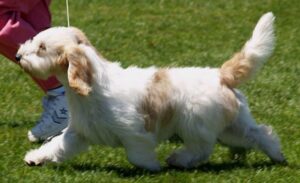
Discover the controversy around grooming the Petit Basset Griffon Vendeen breed with insights from the JEC of the PBGV Club of America.

Discover the facts about a dog’s sense of smell and how it differs from ours. Learn about the nature of a dog’s nose and scent perception.

Discover the controversy around grooming the Petit Basset Griffon Vendeen breed with insights from the JEC of the PBGV Club of America.
The best way to ensure a long and happy relationship with a purebred dog is to purchase one from a responsible breeder. Not sure where to begin?
Contact the National Parent Club’s Breeder Referral Program, which is listed on the AKC Breeder Referral Contacts page.
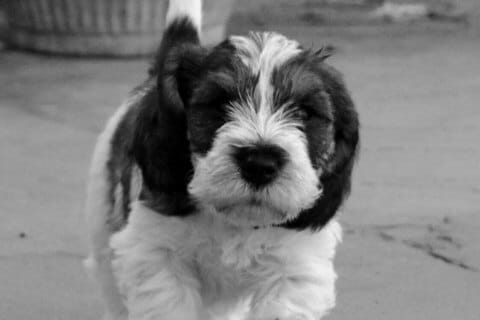

"*" indicates required fields
Showsight Magazine–the world’s most influential purebred dog publication since 1992. Each issue reaches a global audience dedicated to preserving the history and health of purpose bred dogs. Filled with award-winning editorial focused on news and insights from the dog show community, top breeders, handlers, AKC Judges, and more!